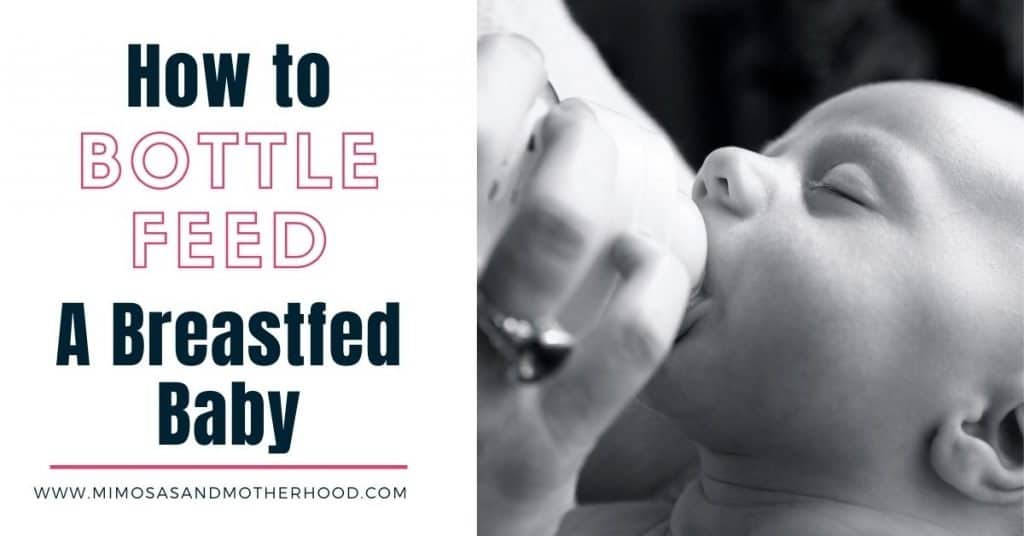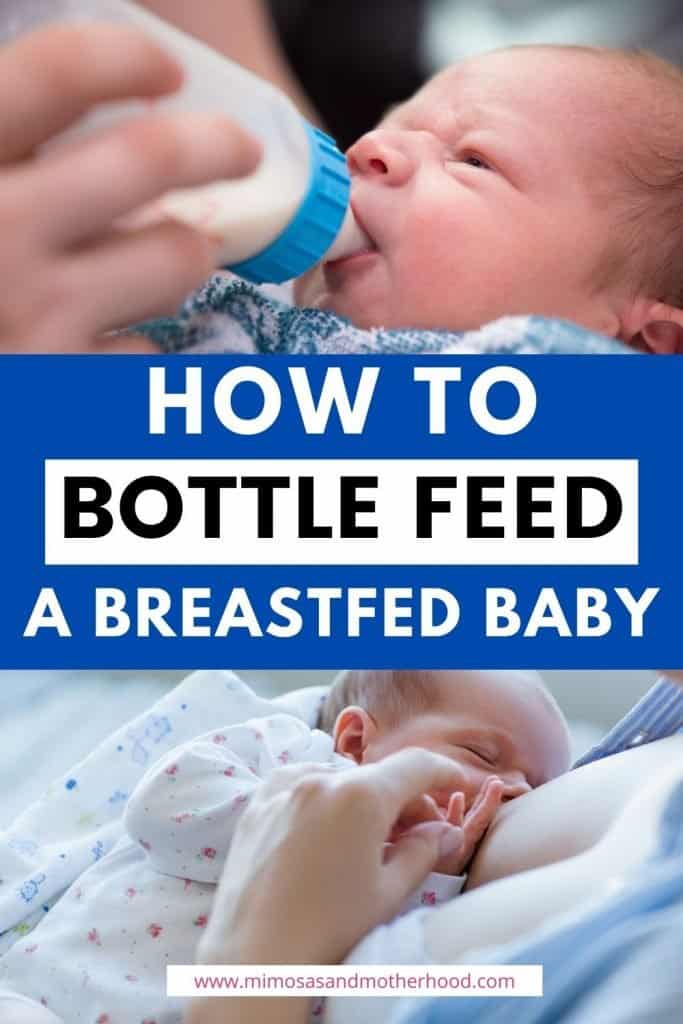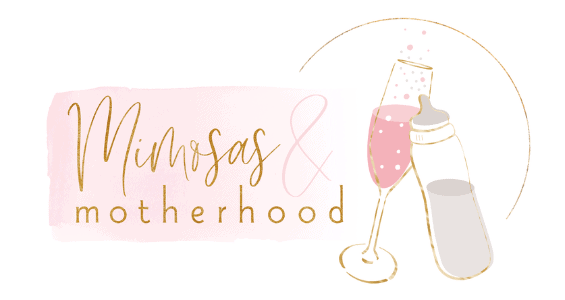Bottle Feeding a Breastfed Baby

Those first few weeks home with your newborn are amazing, but also can be full of challenges. Many moms struggle with breastfeeding, and other moms also struggle with bottle feeding. If you are navigating the waters with both, it can be hard to know where to start with bottle feeding a breastfed baby.
At some point along the breastfeeding journey, problems arise for many moms. Our guest blogger today, Kealy, is a Lactation Counselor, and has helped many mamas through their breastfeeding a bottle feeding journeys.
As a Lactation Counselor, one of the most common problems she sees for breastfed babies comes from giving bottles.
It’s such a common problem that we should talk about it and give moms the tools they need to be successful in the first place! Bottle feeding a breastfed baby is absolutely possible, but should look different than feeding a baby that gets a bottle for every feeding.
Note: Some links may be affiliate links. That means I may make a commission if you use my links to purchase, at no extra added cost to you! I only recommend products that I personally love and believe in. Full disclaimer here.
How Bottle-Feeding Affects a Breastfed Baby
When a breastfed baby is given a bottle, their feeding experience is totally different. They’re used to the breast where they have to suckle before the let-down releases breast milk. Breastfeeding isn’t instantaneous and it takes work from your baby.
But usually, when a baby is given a bottle, they’re laid horizontal on their back with the bottle straight up in the air. This position allows the milk to flow right into your baby’s mouth and into the back of their throat.
Often, moms think that their baby is starving when they give a bottle because they start gulping and eat extremely fast. But it’s not because their baby is starving – it’s because the milk is coming into the back of their throat so fast from gravity that they have to quickly gulp in order to handle it.
If giving a bottle is frequent, the baby can get used to the fast flow. The other thing babies can get used to is the instant flow of milk. With breastfeeding, it takes time for a let-down (when your breasts start to release the milk). When a baby gets a bottle, the first suck is met instantly with the reward of milk.
Eventually, there comes a time that the baby is hungry, wants instant gratification of milk flow, and to be full quickly. They know the bottle will give them that.
But mom tries to breastfeed…
And the baby starts screaming! Sometimes they just fuss. Or maybe they’ll start suckling, become impatient, and cry. In any case, the baby is often frustrated and mom has no idea why her baby is so upset. And she knows her baby is hungry so… she gives them a bottle!
When her baby gulps the bottle down, she thinks her supply isn’t good, she can’t breastfeed or is somehow inadequate.
In reality, it was the bottle causing the problem in the first place.

How to Bottle-Feed a Breastfed Baby
Now that you know the bottle can cause trouble with breastfeeding… what can you do about it?
Well, the best way to bottle-feed a breastfed baby is to make it as close to breastfeeding as possible. La Leche League International has some great tips for introducing a bottle to a breastfed baby, if you’re looking for a little extra advice!
Here are the steps to take for bottle-feeding a breastfed baby:
- Use a slow-flow nipple.
- Have your baby open to latch instead of popping it into their mouth.
- Hold your baby upright and the bottle horizontal.
- Allow your baby to take breaks throughout the feeding.
- Try to make the feeding take as long as a breastfeeding session would take.
Use a slow-flow nipple.
Using a slow-flow nipple will help your baby by reducing the instant gratification of milk. It makes your baby work harder to get the milk out. You could try using a preemie nipple, a newborn nipple, or a size 0 or 1 (depending on the brand). By making it more work to pull the milk out, a smaller size nipple will be more like breastfeeding.
The Dr. Brown’s line of bottles has a fantastic preemie nipple. You can order just the nipples, or a pack of bottles that include them.

SHOP>> Dr. Brown’s Original Nipple, Preemie (0m+),6 Count

SHOP>> Dr. Brown’s Options+ Slow Flow Bottle Set for Breastfed Baby
Have your baby open to latch instead of popping it into their mouth.
Bottles can be super easy to just pop into a baby’s mouth, even if they don’t open their mouth to accept it. But breastfeeding is very different. In order to latch a baby onto the breast, a baby needs to open wide first. Try to mimic the same thing when bottle feeding. Use the bottle nipple to stroke your baby’s lips. Place the nipple under their nose so they smell the milk or formula, and wait until they open wide to place the nipple in their mouth.
Related: Breastfeeding Tips for First Time Moms
Hold your baby upright and the bottle horizontal.
It’s extremely important to take gravity out of the equation. Gravity helps milk flow into a baby’s mouth when the bottle is held upright. The fix is to change your baby’s position. Hold your baby upright and the bottle horizontally. Try tilting the bottle only as much as you need to get milk into the tip of the nipple.
This video shows the correct way to use paced bottle feeding to help a breastfed baby take a bottle:
Allow your baby to take breaks throughout the feeding.
For your baby to take breaks, the bottle should be held horizontal so they aren’t forced to gulp from milk flowing into their mouth. Breastfed babies often take breaks to breathe during a feeding, and bottle feeding should be the same.
When your baby slows their sucking, remove the bottle from their mouth or just tilt it back so milk isn’t in the nipple tip. Then your baby can take a break and breathe as they would breastfeeding. Once your baby starts sucking or rooting again, place the bottle back into their mouth and tilt it forward so there’s milk in the tip.

Try to make the feeding take as long as a breastfeeding session would take.
Using the tips above, try to make bottle-feeding take the same amount of time as a breastfeeding session. Allowing your baby to take breaks while breastfeeding is called paced feeding. Taking the same amount of time for feeding will reduce the effect the bottle has on your baby and encourage them to continue being happy at the breast.
What to Do if Your Baby Prefers the Bottle
If you think that your baby has a preference for the bottle, don’t worry! Some moms decide they want to pump full-time and are very successful with it. But if you want to get your baby back to the breast, follow the steps above.
Your baby might be upset at first because they want ALL the milk NOW! That’s okay, just try to ease them into it.
Start by first changing the nipple size to a smaller one and giving them the bottle only after they’ve opened wide to latch. If your baby does okay with that, then start sitting them more upright for feedings.
Try feeding your baby before they become extremely hungry. If you offer the bottle sooner, they may feed slower allowing you to pace the feeding more easily.
Keep times at the breast happy! This is the most important part.
Don’t try to force your baby to breastfeed if they’re screaming and upset. Sometimes fixing the problem takes time, and that’s okay. Offer a bottle using the above techniques. Then, spend time skin-to-skin often.
Cuddle your baby. Don’t pressure them to feed. Spend time with your baby near your breasts after a bottle feeding. Just let them re-learn that breastfeeding, suckling, and being near your chest are happy things. With time, you’ll overcome this bump in the road.
If you need extra help, reach out to a local Lactation Consultant, or find a breastfeeding support group. A little support goes a long way. You can find an International Board Certified Lactation Consultant (or IBCLC) near you here.

Conclusion
Breastfeeding moms need to know how to give a bottle – and that it’s different than babies who get a bottle all the time! So many moms encounter this problem, and little tips about how to bottle-feed a breastfed baby can make all the difference.
Making bottle-feeding more like breastfeeding can help support the breastfeeding journey and avoid bumps in the road.
For even more information about breastfeeding and bottle feeding, be sure to also read Breastfeeding Tips for First Time Moms, The Best Pacifiers for Breastfed Babies and The Best Breastfeeding Accessories.
About Kealy
Kealy is a Registered Nurse, Certified Lactation Counselor, and most importantly a mommy! Her own breastfeeding struggles gave her a passion to help moms throughout their breastfeeding journey. She offers one-on-one lactation consultations, breastfeeding classes, and shares her knowledge to equip and empower moms. If you’re interested in talking with her or taking one of her breastfeeding classes, visit www.littlebearcare.com.








Thank you for having me as a guest to write this article! It’s so important that moma are equipped with the knowledge and support they need to breastfeed successfully.
Thank you for sharing your knowledge with my readers!
Those Dr. Brown bottles were a lifesaver for me! My baby wouldn’t take any others.
Same! I really struggled with our first, and discovering those preemie nipples (along with paced bottle feeding) was such a game changer.